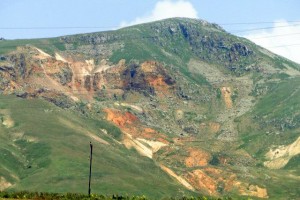Armenian steppe viper: Red Data Book of Armenia

Vipers and Pitvipers — Viperidae
Status. An endemic of the Armenian Highland. Listed in the IUCN Red List of Threatened Species (ver. 3.1) as Vulnerable VU B1ab(iii,v). According to IUCN criteria categorized as Vulnerable VU B1ab(iii,v).
Distribution. Distributed in the mountains of the eastern part of the South Caucasus and the adjacent areas of Turkey and Iran.
Distribution in Armenia. Occurs in the country’s north–western, central and southern areas, mainly in grassland landscapes and highland meadows at 1200–3000 m above sea level.
Habitats. In Armenia inhabits stony arid grasslands and alpine meadows. Also occurs in montane sparse forests, rocky agglomerations on slopes and xerophilic vegetation like milk vetch. Sometimes can be found also on cultivated lands, underneath the stones. Uses rodent burrows, hollow spaces between stones, scrub roots, rock crevices and ground cracks as shelters.
Biological traits. Active from mid–April to mid–October. Feeds on invertebrates and lizards. Mating occurs in April–May, depending on habitat elevations and time of hibernation end. Ovoviviparous. The offspring are born from late July to mid–September. The gestation period is 90–130 days.
Population size and its trends. The population size is not big, but in foothill habitats or between stones they can concentrate at the density as high as 6–8 individuals/ha. Generally, the population is stable due to its distribution on higher elevations.
Major threats. Sheep and goat grazing in grasslands and meadows.
Conservation measures. Protected in Khosrov Forest Reserve’s small areas of mountain meadows. It is essential to grant protection to small isolated populations in Northern Armenia, set them aside as sanctuaries and to enlarge the size of Khosrov Forest Reserve.
Suggestions
 The Ministry of Environment sent a letter international partners to draw their attention to the real danger of environmental disasters as a result of Azerbaijan's large-scale aggression towards the territory of Armenia
The Ministry of Environment sent a letter international partners to draw their attention to the real danger of environmental disasters as a result of Azerbaijan's large-scale aggression towards the territory of Armenia
 Launch of Amulsar Construction Is End to Little Armenian Switzerland-Jermuk
Launch of Amulsar Construction Is End to Little Armenian Switzerland-Jermuk
 According to Nature Protection Ministry RA, Emissions 'Pure Iron' CJSC and 'Armenian Titanium Production' LLC within Standards
According to Nature Protection Ministry RA, Emissions 'Pure Iron' CJSC and 'Armenian Titanium Production' LLC within Standards
 Vicia pisiformis: Red Data Book of Armenia
Vicia pisiformis: Red Data Book of Armenia
 Vavilovia formosa: Red Data Book of Armenia
Vavilovia formosa: Red Data Book of Armenia












